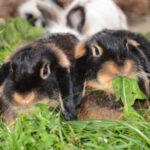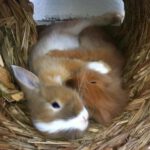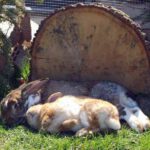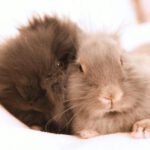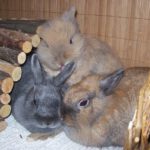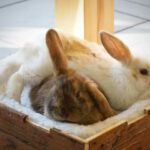Contents
- Crude fiber plays a major role in rabbit nutrition. But why is that?
- How does the cecum work?
- Analytical methods
- What’s behind the different fiber types?
- Digestibility
- „Cecal Bacterial Food
- Comparison between natural feeding (wild plants and fresh grass) and winter feeding or when collection from nature is not possible (hay, leafy vegetables…)
Crude fiber plays a major role in rabbit nutrition. But why is that?
Rabbits have a highly specialized digestive system that not only breaks down food with enzymes, as in dogs and cats, but also digests parts that are indigestible for humans through a unique process in the cecum. This bacterial fermentation in the cecum requires a high ‚crude fiber content.‘ However, not all types of crude fiber are the same.
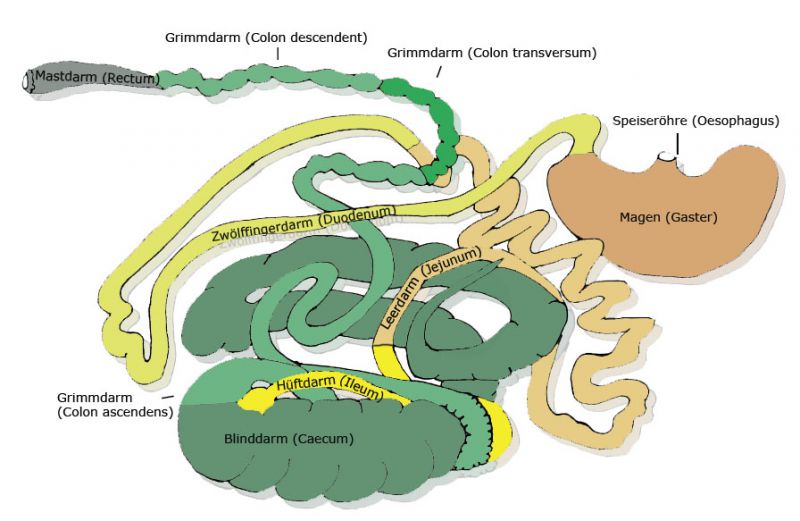
How does the cecum work?
The cecum is home to numerous bacteria that break down fibers indigestible to humans through bacterial fermentation. This process synthesizes fatty acids as well as B and K vitamins. This mechanism is remarkable, as it enables rabbits to digest plants that would not serve as a food source for animals without bacterial fermentation. The cecum provides rabbits with 10-12% of their energy needs in the form of volatile fatty acids. After producing soft feces during the cecal phase, the rabbit excretes this material, re-ingests it, and can then absorb the nutrients through the small intestine.
Analytical methods
Crude fiber refers to the portion of feed that is insoluble in sulfuric acid and potassium hydroxide, including cellulose, hemicellulose, and lignin. For rabbits, the crude fiber content is not very informative, as it includes both digestible components and indigestible fibers (which are important for gut health).
There are different methods for feed analysis. The ‚crude fiber content‘ is determined through the Weende analysis. However, for fiber analysis in rabbit nutrition, the Van Soest analysis is key:
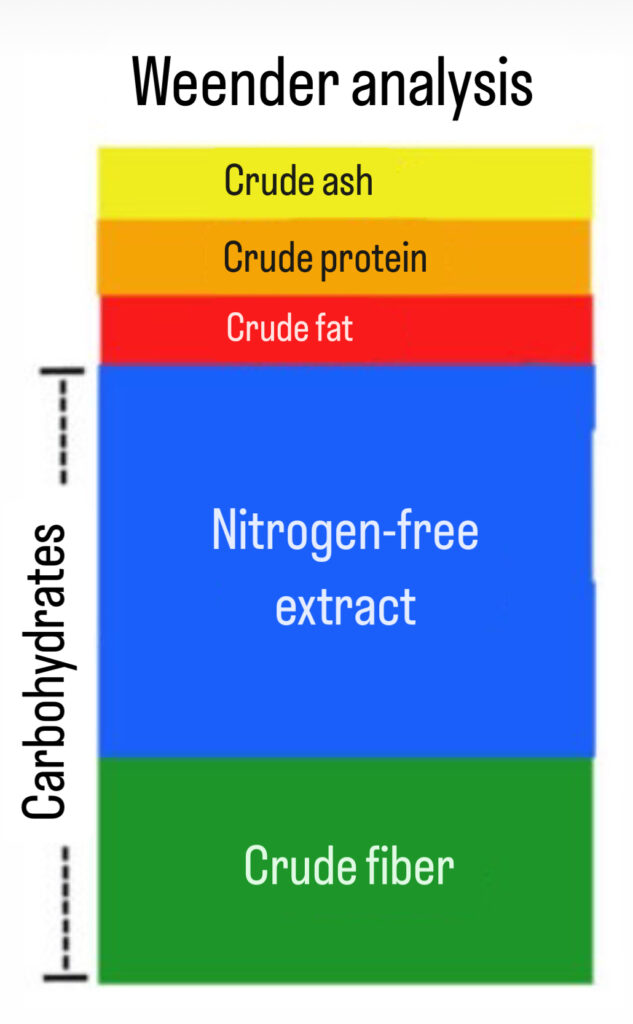
NON-FIBER CARBOHYDRATES (NFC): Non-fiber carbohydrates (NFC) represent the soluble carbohydrates, such as starch, sugars, and pectins, found in feed. These are digested by enzymes outside the cecum. A high NFC content can result in undigested NFCs that disrupt the specialized bacterial flora in the cecum.
NEUTRAL DETERGENT FIBER (NDF): Neutral detergent fiber (NDF) includes hemicellulose, cellulose, and lignin, primarily representing plant cell walls. Typical NDF analysis also captures silica and silicates. NDF essentially consists of fibers that feed cecal bacteria and help maintain digestive stability in rabbits.
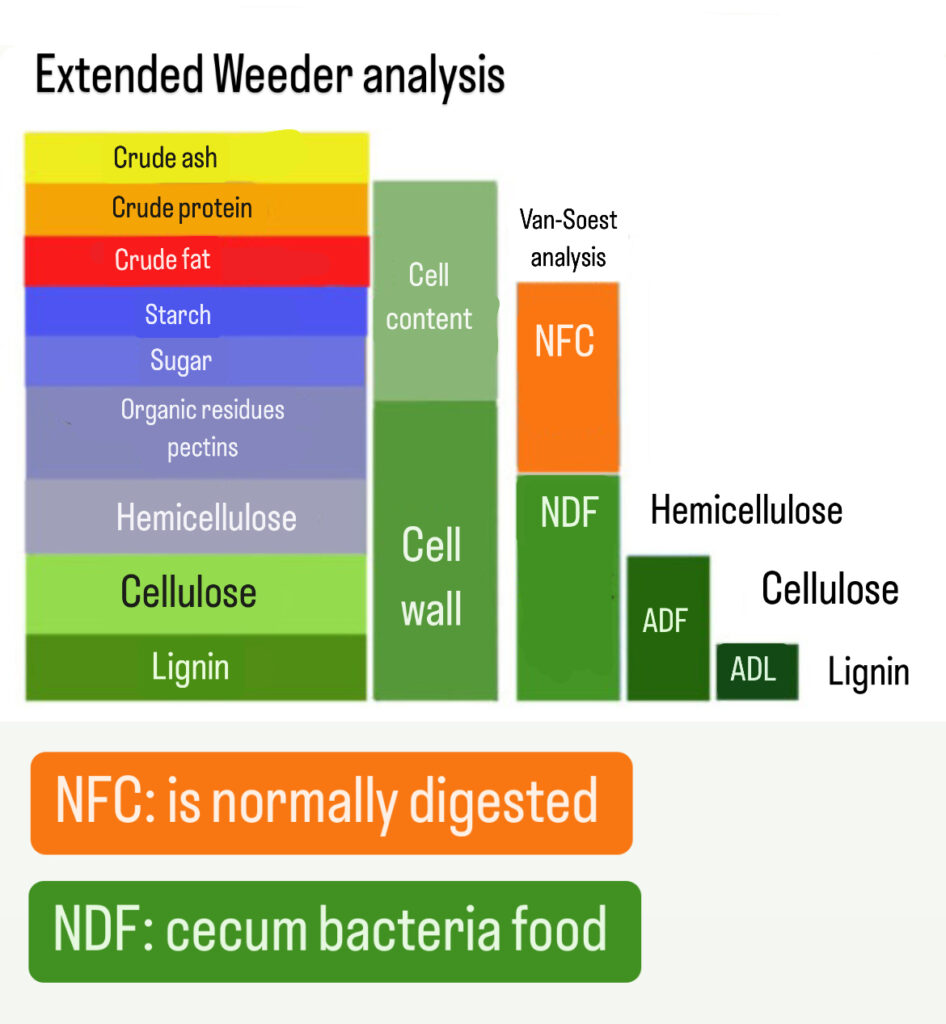
NFC = Non-fibrous carbohydrates (composed of starch, sugar, and pectins)
NDF = Neutral detergent fiber (composed of hemicellulose, cellulose, and lignin)
ADF = Acid detergent fiber (composed of cellulose and lignin)
ADL = Lignin
Hemicellulose = NDF – ADF
Cellulose = ADF – ADL
Lignin = ADL
What’s behind the different fiber types?

NFC: Primarily digested by enzymes in the small intestine; too much can reach the cecum and cause digestive issues.
- Sugar (Glucose): High in fruits and also found in sweet-tasting vegetables.
- Starch: High levels in grains, pea flakes, and also present in fruits and vegetables.
- Pectins: Found in fruits and vegetables, such as apples and carrots.
NDF: ‚Structural fiber,‘ mainly digested in the cecum and colon; serves as ‚bacterial food.‘
- Hemicellulose: High levels in woody plant parts (e.g., grasses, herbs, bark) and present in smaller amounts in fruits and vegetables.
ADF: A high proportion is ideal for digestive health.
- Cellulose: The main component of plant cell walls.
- ADL: Lignin.
- Lignin: Found in highly lignified plants, such as bark, and in smaller amounts in all plants, including vegetables and fruits.
Digestibility
Pectins have a very high digestibility in rabbits, ranging from 70 to 76%, but they also serve as good bacterial food in the cecum.
Hemicelluloses are on average 25 to 35% digestible in rabbits,
Cellulose is between 15 and 18%,
Lignin is on average 10 to 15% digestible.
„Cecal Bacterial Food
According to Gidenne and Lebas (2002), to prevent digestive diseases, the diet should contain more than 15% ADF (cellulose and lignin) and maintain a ratio of ‚digestible fiber‘ (hemicellulose and pectins) to ADF of less than 1.3. This means that a higher content of ADF (cellulose and lignin) is beneficial for gut health.
However, the ratio of NDF (starch and sugar) to NFC (hemicellulose, cellulose, lignin) also plays a significant role. An excess of starch and sugar can result in incomplete enzymatic digestion in the digestive tract, leading to these substances reaching the cecum and disrupting the bacterial flora. The result is the excretion of undigested cecal feces due to a bacterial imbalance in the cecum.
The lignin content in the feed should be around 5%, according to studies, to reduce digestive disorders (too little lignin) or prevent restricting feed utilization too much (too much lignin).
Comparison between natural feeding (wild plants and fresh grass) and winter feeding or when collection from nature is not possible (hay, leafy vegetables…)
Two foods may have the same crude fiber content, but be digestible in different proportions, which can either support a healthy digestion or, conversely, overload it. What really matters is the lignin and cellulose content, not the total crude fiber content, as these fractions are ‚cecal food.‘
When wild plants and fresh grass are not available, hay is irreplaceable, as leafy vegetables do not contain enough indigestible fibers.
Sources include:
Gidenne, T., Jehl, N., Segura, M., & Michalet-Doreau, B. (2002): Microbial activity in the caecum of the rabbit around weaning: impact of a dietary fibre deficiency and of intake level. Animal Feed Science and Technology, 99(1-4), 107-118.
Gidenne, T. (2000): Recent advances in rabbit nutrition: Emphasis on fibre requirements. A review.
World Rabbit Science 8 (1), 23-32
Gidenne, T. (2015): Dietary fibres in the nutrition of the growing rabbit and recommendations to preserve digestive health: a review. Animal, :(2), 227-242.
Gidenne, T. (2003): Fibres in rabbit feeding for digestive troubles prevention: respective role of low-digested and digestible fibre
Livestock Production Science 81, 105-117










